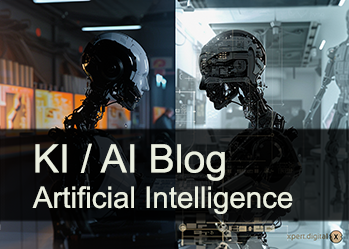Comprehensive analysis of the global AI landscape: the current state of artificial intelligence (July 2025)
Xpert pre-release
Language selection 📢
Published on: July 16, 2025 / update from: July 16, 2025 - Author: Konrad Wolfenstein

Comprehensive analysis of the global AI landscape: The current state of artificial intelligence (July 2025)-Image: Xpert.digital
Ethics, economy, innovation: the AI transformation at a glance (reading time: 41 min / no advertising / no paywall)
Between hope and risk - the complex future of artificial intelligence
Artificial intelligence (AI) has long since developed from a niche topic of computer science one of the most driving and disruptive forces of our time. It dominates the headlines, influences global markets and changes the way we work, communicate and live. But behind the hype is a complex reality that is characterized by immense economic opportunities, geopolitical power struggles, profound ethical questions and rapid technological jumps.
This article illuminates the multi -layered world of AI using current developments. We immerse yourself in the massive investments that lay the foundation for the AI future, analyze the global race for supremacy in AI chips, examine the diverse areas of application from medicine to the military and confront the risks and ethical dilemmata that are associated with this transformative technology. The aim is to draw a nuanced picture that illustrates both the enormous potential and the urgent challenges of the AI revolution.
1. Why are we currently experiencing such a massive investment boom in the AI infrastructure, especially in data centers?
The current investment boom in the AI infrastructure is the direct result of the fundamental requirements of modern AI models, in particular the so-called Large Language Models (LLMS) and generative AI systems. These systems are the digital equivalent to huge brains that need an unimaginable amount of computing power to "learn" and "function". You can divid the driving forces behind these investments into three main areas:
The training of AI models: The “training” of an advanced AI model such as GPT-4, Claude 3 or Gemini is an extremely arithmetic process. Huge amounts of data (often a large part of the Internet) are supplied to the model so that it can learn patterns, relationships, language structures and factual knowledge. This process can take weeks or months and requires thousands of specialized AI chips (GPUS) that work in parallel. The cost of training a single state -of -the -art model can amount to hundreds of millions or even over a billion dollars. Companies such as Google, Meta and Openaai must either build up this infrastructure themselves or rent expensive in order to stay at the top in competition.
The inference (application of the AI): After training, the model is ready for the application, the so -called “inference”. Every time a user makes an inquiry to chatt, generates an image with Midjourney or requested a translation with Deepl, the trained model must be activated to calculate an answer. Although a single inference request needs far less computing power than training, billions of inquiries from millions of users worldwide add up to an enormous, constant need for computing capacity. The tech giants build gigantic data centers to operate this global demand and to offer fast, reliable AI services.
The cloud computing market: A significant part of the investments not only flows into the infrastructure for your own products, but also into the expansion of cloud services. Companies such as Amazon (AWS), Microsoft (Azure) and Google (Cloud) offer other companies “Ai as a Service”. This means that start-ups and established companies that themselves do not have the means of building their own data centers can flexibly rent the necessary AI calculation performance. This market is extremely lucrative. Anyone who can offer the largest, fastest and most efficient AI infrastructure will secure a decisive competitive advantage. Players such as CoreWeave, a specialized cloud provider for AI workloads, are an example for new companies that advance in this highly profitable niche and invest billions.
In summary, it can be said that the massive investments are not speculation, but a necessity. Without these gigantic, energy -hungry data centers, there would be no generative AI that we know them today. They are the physical backbone of an increasingly digital and intelligent global economy.
Suitable for:
2. What makes a state like Pennsylvania an emerging center for AI and energy investments?
The development of Pennsylvania on a hotspot for AI investments is a fascinating example of the interaction of politics, geography and economic necessity. There are several factors fueling this trend, heated by targeted political initiatives of personalities such as former President Donald Trump and the politician David McCormick.
Energy availability and costs: The most important factor is energy. As already mentioned, the energy hungry of AI data centers is enormous. Pennsylvania is one of the largest natural gas producers in the United States (thanks to the Marcellus-Shale deposit). This abundant availability of relatively inexpensive energy is a massive location advantage. While many tech companies focus on renewable energies, the stable and predictable base load supply by gas power plants for 24/7 operation of data centers is invaluable. The political support for the use of these fossil fuels in the region lowers the hurdles for the construction of new power plants to supply data centers.
Geographical location and infrastructure: Pennsylvania is strategically cheap near the large population and economic centers of the US East Coast (New York, Washington DC, Boston). This reduces latency time, i.e. the delay in data transmission, which is critical of many AI applications. In addition, the state has a well -developed industrial infrastructure, sufficient land for large construction projects and a tradition in the field of heavy industry, which means qualified workers for the construction and maintenance of such systems.
Political will and incentives: The explicit funding from influential politicians creates an investment -friendly climate. When personalities such as Trump and McCormick Pennsylvania position as “Center for AI and Energy”, this sends a strong signal to investors. Such initiatives are often associated with tax incentives, accelerated approval processes and direct subsidies to attract companies. This creates a political dynamic that brings the state in competition with other regions such as Virginia or Ohio, which also promotes data centers.
Economic change: Pennsylvania is part of the so -called “Rust Belt”, a region that is characterized by the decline of the traditional heavy industry. The settlement of state -of -the -art data centers is seen as an opportunity to initiate an economic structural change, to create new, sustainable jobs and to reposition the region technologically.
The convergence of cheap energy, political support and strategic situation thus makes Pennsylvania a prime example of how the digital needs of the Ki era affect the physical and political realities of a region and create new economic centers.
Suitable for:
- Market analysis Pennsylvania: target industries for mechanical engineering and automation technology
3. The immense energy requirement of AI is increasingly discussed as a problem. What are the dimensions of this problem and which specific solutions are being pursued?
The energy requirement of the AI industry is indeed one of the biggest challenges and potentially one of its Achilles' heels. The problem has several dimensions:
Scaling: Individual AI requests are not the problem, but it is global scaling. It is estimated that the energy consumption of the AI sector could increase exponentially in the coming years. Some forecasts assume that AI calculating centers could consume as much electricity by 2027 as entire countries in Sweden or the Netherlands. This exerts enormous pressure on the existing electricity grids, which are already working at their capacity limit in many regions.
CO2 footprint: If this energy requirement is mainly covered from fossil fuels, the AI boom counteracts the global climate goals. The production of the hardware (especially the chips) is also very energy and resource-intensive.
Water consumption: data centers need huge amounts of water to cool. In low -water regions, this can lead to conflicts with agricultural use or drinking water supply.
In view of these challenges, intensive solutions are pursued at different levels:
Use of renewable energies: This is the most prominent approach. Tech giants such as Google and Microsoft have undertaken to complete their data centers up to a certain date with renewable energies. This is done by the direct construction of solar and wind farms or by concluding long-term electricity acceptance contracts (Power Purchase Agreements). A particularly interesting trend is the use of hydropower. Hydropower plants provide a very stable and predictable energy supply, which fits perfectly with the constant energy requirement of data centers. Locations near large hydropower plants (e.g. in the northwest of the USA or Scandinavia) are therefore becoming increasingly attractive.
Improvement of energy efficiency (hardware): The chip manufacturers work feverishly to increase the efficiency of their processors. Each new generation of AI chips should deliver more arithmetic operations per watt (flops/watts). This includes new chip architectures, smaller manufacturing sizes (nanometer range) and specialized designs that are tailored to AI tasks.
More efficient cooling systems: The traditional air conditioning of data centers is extremely energy -intensive. Modern approaches include fluid cooling, in which the chips are washed directly by a coolant, which is far more efficient than air cooling. The use of cold outside air (free cooling) in cooler climate zones is also a common practice.
Algorithmic optimization (software): It's not just about the hardware. Researchers are working on making AI models “slimmer” and more efficient. Techniques such as “Model Pruning” (removing unnecessary parts of a neuronal network), “quantization” (use of a lower numerical precision) and the development of smaller, specialized models can drastically reduce the computing effort for training and inference without significantly impairing.
Intelligent load management: AI can also contribute to solving your own energy problem. Intelligent management systems can dynamically shift arithmetic loads in data centers where there is a surplus of renewable energy (e.g. in a sunny or windy region).
The solution is therefore in a holistic approach that ranges from electricity generation to chip architecture and software to the intelligent operation of the data centers.
4. How ambivalent are the effects of the AI on the labor market? Where are new jobs and where are the biggest losses threatening?
The effects of the AI on the labor market are deeply ambivalent and one of the most discussed socio -economic questions of our time. It is a classic case of creative destruction, in which jobs are also destroyed and new ones are created. It is not a pure job killer, but also not a pure job engine.
Positive effects and job acquisition:
Construction and operation of infrastructure: The boom in the construction of data centers creates thousands of workplaces for construction workers, electricians, engineers and security personnel directly. The operation and maintenance of these highly complex systems also require specialized technicians and IT specialists.
AI development and research: The demand for talents that can develop, train and refine AI models has exploded. This includes roles such as AI researchers, machine learning engineers, data scientists and specialists for neural networks. These highly qualified and well-paid jobs are the core of the AI industry.
New job profiles: AI creates completely new professions. A prominent example is the prompt engineer, a person who specializes in formulating the best possible instructions (prompt) in order to obtain the desired results of generative AI models. Further new roles are created in the areas of AI ethics, AI auditing and AI implementation advice.
Increase in productivity: AI can serve as a tool that makes human workers more productive. A programmer can write a faster code with a AI copilot, a designer can create designs faster with AI image generators, and a marketer can develop faster campaigns with AI text generators. This can lead to economic growth, which in turn creates new jobs in other sectors.
Negative effects and job losses:
The greatest threat is based on automation of cognitive routine tasks. These are activities that were previously considered safe because they required intellectual work but can now be taken over by AI systems. Above all, it is affected:
Data analysis and reporting: Many tasks in the field of simple data analysis, the creation of reports and the summary of information can now be done faster and often more error-free than by human analysts. Junior positions in this area are at risk.
Customer service and support: Chatbots and voices of the latest generation can understand and edit complex customer inquiries. This leads to massive job cuts in call centers and in first level support.
Content creation and text position: simple texts, product descriptions, social media posts or even standard journalistic standard messages can be generated by AI. This threatens jobs in content marketing, in text position and entry journalism.
Paral shelves and administrative activities: KI can search and summarize huge amounts of legal documents, contracts and case files in a matter of seconds - a task that was previously done by lawyers or young lawyers.
The crucial question for the future will be whether the creation of new jobs can keep up with the pace of job losses and whether our companies are able to provide the necessary retraining and further education programs to qualify the workers for the new requirements of the AI era.
5. Nvidia dominates the market for AI chips. How did this dominance come about and what role does the competition play like AMD?
Nvidia's overwhelming dominance in the AI chip market is not a coincidence, but the result of a farsighted strategy that began over 15 years ago. Nvidia was originally a manufacturer of graphics processors (GPUS) for the gaming industry. The architecture of GPUs, which is designed to carry out thousands of simple calculations in parallel (to render pixels on a screen), proved to be perfect for the type of matrix multiplications that form the heart of deep learning algorithms.
The decisive factors for Nvidia's success were:
Cuda-The software ecosystem: Nvidia's greatest strategic advantage is not only the hardware, but the software platform Cuda (Compute Unified Device Architecture). Already published in 2007, CUDA developers enabled the massive parallel calculation to use the NVIDIA GPUs for general scientific and data-intensive calculations-not just for graphics. Over the years, Nvidia has built up a huge, mature and robust ecosystem of libraries, tools and optimized algorithms around Cuda. Researchers and developers in the ACI area have got used to this ecosystem. A change to another platform would be associated with enormous effort, since millions of code lines would have to be rewritten. This creates a strong “lock-in effect”.
Early focus on AI: Nvidia recognized the potential of deep learning earlier and more consistently than its competitors. They developed special hardware features into their GPUs (such as the tensor cores), which are tailored to the needs of AI workloads, and specifically market their products to the AI research community.
Continuous innovation: NVIDIA has established a merciless innovation cycle and brings a new, much more powerful chip generation to the market every 18-24 months (e.g. Pascal, Volta, Ampere, Hopper, Blackwell). These constant increases in performance make it extremely difficult for competitors to catch up.
The competition, especially AMD (Advanced Micro Devices), has underestimated this trend for a long time, but now catches up. AMD's strategy focuses on offering a powerful alternative to Nvidia's hardware, especially with its instinct series from data center GPU (e.g. MI300X). AMD's biggest challenge is to build a competitive software ecosystem for your hardware offer. Your software platform ROCM should be an alternative to Cuda, but is not yet mature, widespread or easy to use.
Nevertheless, the increasing competition through AMD is of crucial importance. It can help reduce the extremely high prices for AI chips, to diversify the supply chains and to further drive the innovation. Other tech giants such as Google (with your TPUS), Amazon (with trainium and Inferentia) and Microsoft develop their own AI chips to reduce their dependence on Nvidia, which further increases competitive pressure.
🎯📊 Integration of an independent and cross-data source-wide AI platform 🤖🌐 for all company matters

Integration of an independent and cross-data source-wide AI platform for all company matters-Image: Xpert.digital
Ki-Gamechanger: The most flexible AI platform-tailor-made solutions that reduce costs, improve their decisions and increase efficiency
Independent AI platform: Integrates all relevant company data sources
- This AI platform interacts with all specific data sources
- From SAP, Microsoft, Jira, Confluence, Salesforce, Zoom, Dropbox and many other data management systems
- Fast AI integration: tailor-made AI solutions for companies in hours or days instead of months
- Flexible infrastructure: cloud-based or hosting in your own data center (Germany, Europe, free choice of location)
- Highest data security: Use in law firms is the safe evidence
- Use across a wide variety of company data sources
- Choice of your own or various AI models (DE, EU, USA, CN)
Challenges that our AI platform solves
- A lack of accuracy of conventional AI solutions
- Data protection and secure management of sensitive data
- High costs and complexity of individual AI development
- Lack of qualified AI
- Integration of AI into existing IT systems
More about it here:
AI strategies revealed: export controls and their global consequences-the secret AI chips war between the USA and China
6. The US government tries to limit China's access to progressive AI chips. How do these export controls work and how effective are they really?
The US export controls for AI chips are a central instrument in the geopolitical and technological race with China. The declared goal is to slow down the development of China's military skills, its surveillance technologies and its general AI management position by preventing access to the necessary high-performance hardware.
How the controls work:
The controls managed by the US Ministry of Trade define specific technical power thresholds. Chips that exceed these thresholds must not be exported to China (and other countries classified as questionable) without a special license. The most important criteria are:
Computing power: The maximum number of arithmetic operations that a chip can carry out per second (measured in Tflops or peta flops).
Transfer speed (Interconnect Speed): The speed at which several chips can communicate with each other. This is crucial for the training of large AI models, in which thousands of chips have to work together.
The challenge of effectiveness and the circumvention strategies:
The effectiveness of these controls is the subject of intensive debates. A classic cat-and-mouse game shows:
“Export-compliant” chips: In response to the first controls, NVIDIA developed special, slightly throttled versions of their chips for the Chinese market (e.g. A800 and H800). These were just below the power thresholds and could be legally exported. When the US government tightened the controls and also blocked these chips, Nvidia announced a new generation even more adapted chips, such as the H20. These chips are significantly reduced in their performance, especially in the chip-to-chip communication that is important for training large models.
The “4th Best” approach: The strategy of the United States is that China gets AI chips, but not the absolutely best. According to a report, China almost only receives the “fourth best” technology available. This slows down China, but does not stop it. It forces Chinese companies to work with less efficient hardware, which makes training and development more expensive and time -consuming.
Gray markets and smuggling: There are reports of a flourishing black market on which powerful Nvidia chips are smuggled over third countries to China, albeit in smaller quantities and at excess prices.
Course of the domestic industry: Perhaps the most important long-term episode of the US sanctions is that they massively inspire China to build up their own, independent semiconductor industry. Chinese companies such as Huawei (with the Ascend chip) and others receive massive state subsidies to develop and produce competitive AI chips. Even if they are technologically behind Nvidia for several years, the US printing forces China to self-sufficiency. In the long term, the US sanctions could unintentionally create a powerful competitor.
In summary, it can be said that export controls are effective in the short to medium term to slow China's progress and to give it a technological disadvantage. In the long term, however, you have the risk of fueling China's own innovative strength and further split the global technology landscape.
Suitable for:
7. What is meant by the “Ai Race” and what geopolitical dimensions does this race for AI pre-resistance have?
Answer: The term “AI Race” (AI race), which is prominently used by Donald Trump, among other things, describes the intensive global competition between nations about the management position in the development and application of artificial intelligence. This race is much more than just an economic competition; He has profound geopolitical, military and ideological dimensions, which are often compared to the race into space during the Cold War.
The central dimensions of this race are:
Economic dominance: The nation that leads the AI development is expected to gain an enormous economic advantage. KI has the potential to revolutionize productivity in almost all economic sectors, from manufacturing to financial services to healthcare. The leading AI nations will control the platforms, standards and companies of the future and thus secure prosperity and influence. The USA, with its tech giants such as Google, Meta, Microsoft and Nvidia, are currently clearly in the lead.
Military superiority: AI changes the battlefield of the future. It is used for autonomous weapon systems (drone swarms, robots), for the intelligence analysis (evaluation of satellite images and communication in real time), for cyber security and for command and control systems. A military superiority in the AI is considered crucial for national security in the 21st century. This is a main reason for the US efforts to hinder China's military AI development through chip sanctions.
Technological sovereignty: there is a growing concern of dependencies. Countries like Germany and the European Union overall strive to build their own AI competence and infrastructure in order not to be completely dependent on US or Chinese technologies. This “technological sovereignty” is intended to ensure that you keep control of critical digital infrastructures and enforce your own rules based on European values (e.g. in data protection).
Normative and ethical leadership: Anyone who is the leading AI power also has the greatest opportunity to shape the global norms and rules for the use of AI. The United States and Europe often emphasize a human -centered, democratic and ethical approach for AI. In contrast, it is feared that China could export a model of AI-based authoritarian surveillance and social control. The “AI Race” is also a race for value systems.
Trump's statement to emphasize the need to "put the United States in the lead" is symptomatic of this way of thinking. It reflects the conviction that the leadership in the ACI area is a question of national priority that decides on economic prosperity, military security and global influence in the coming century.
Suitable for:
8. How concrete is KI already used in sectors such as financial services and retail?
Answer: Financial services and retail sectors are already deeply anchored and has long since left the status of a pure experiment. It has become a decisive tool for efficiency, personalization and risk management.
In the financial sector:
Data-based decisions: AI systems, such as the Claude model developed by Anthropic, can analyze huge amounts of unstructured data that could not be mastered for human analysts. This includes financial news, analyst reports, social media moods and quarterly reports. The AI can extract from this in a matter of second trends, risks and opportunities and thus provide investment bankers and fund managers in a more informed basis for decision -making.
Algorithmic trade: High frequency trading companies have been using AI for years to react to market fluctuations in milliseconds and make trading decisions. Modern AI models can recognize even more complex patterns and develop forward-looking trade strategies.
Credit risk assessment: Banks use AI to assess the creditworthiness of applicants. AI models can take a much larger number of data points into account than traditional scoring models, which can lead to more precise risk forecasts. However, this also harbors the risk of bias (BIAS) when the training data reflects historical discrimination.
Fraud recognition: AI is extremely effective when recognizing abnormal patterns that indicate fraud, e.g. B. in credit card transactions or insurance claims. It can mark suspicious activities in real time and thus prevent financial damage.
In retail:
Hyper-personalization: This is perhaps the most visible use of AI. Companies like Amazon and Shopify use AI to individually design the shopping experience for every customer. The AI analyzes the previous purchase and surfing behavior in order to display personalized product recommendations, send tailor-made marketing emails and even optimize the arrangement of the products on the website for every user.
Dynamic pricing: AI systems can adapt prices in real time, based on factors such as demand, inventory, competitor prices and even time of day.
Optimization of the supply chain: KI predicts the demand for certain products much more precisely than traditional methods. This helps retailers to optimize their inventory, to avoid excess stands and to ensure that popular products are always available.
AI-supported customer service chatbots: Modern chatbots can answer customer questions about products, delivery status or return conditions and thus relieve the human service staff.
In both sectors, AI acts as a powerful multiplier that enables companies to draw a real business value from the flood of data they collect.
9. What revolutionary progress enables AI in healthcare and medicine?
Answer: The healthcare system is one of the areas in which AI has the greatest potential to directly improve and save human life. The ability of the AI to recognize complex patterns in medical data that are invisible to the human eye leads to groundbreaking applications:
Diagnostics in imaging (radiology): This is one of the most advanced fields. AI algorithms that have been trained in millions of medical images (MRI, CT, X-rays) can often recognize signs of diseases earlier and more precisely than human radiologists.
Breast cancer diagnostics: AI systems can analyze mammographies and mark suspicious areas with high precision. Studies have shown that AI can reduce radiologists' workload and improve the detection rate of tumors.
Diagnosis of pancreatic cysts: AI is used to identify potentially malignant cysts on scans, which is crucial, since pancreatic cancer is often only discovered in a late, terminal stage.
The American College of Radiology (ACR) even founded its own committee to examine the economic and clinical effects of AI in radiology, which underlines the importance of this technology.
Personalized medicine: AI can analyze the genetic data of a patient, his lifestyle factors and his medical history in order to create tailor -made treatment plans. It can predict which patient will best respond to a certain medication and thus increase the effectiveness of therapies and minimize side effects.
Active substance discovery and development: The process of developing new medication is extremely lengthy and expensive. AI can drastically accelerate this process by analyzing and predicting molecular structures, which of them can be considered as potential active ingredients against a certain disease.
Operative support: AI systems can give real-time feedback on surgeons during operations by highlighting anatomical structures on the screen or warning of risks.
Despite the enormous potential, there are also challenges such as data protection for sensitive health data, the need for the official approval of AI systems and the question of the final responsibility in the event of misdiagnoses.
10. How does Ki find her way into rather unexpected areas such as education, agriculture or even religion?
Answer: The omnipresence of AI is shown by the fact that it increasingly also penetrates in sectors that are not immediately associated with high technology.
Education: AI has the potential to personalize education. AI tutor systems can adapt to the learning pace of each individual student, provide additional exercises where it is necessary and help teachers to better understand the learning progress of their classes. At the same time there are major challenges: How do you deal with AI-generated homework? How do you convey a critical handling of technology to students? The fact that more than half of the US states have published guidelines for the use of AI in schools shows the urgency and relevance of the topic. Universities set up special committees to develop a strategy for dealing with AI in teaching and research.
Agriculture: The precision agriculture uses AI to maximize income and minimize the use of resources such as water, fertilizer and pesticides. AI-based systems analyze data from satellites, drones and floor sensors to give farmers optimized crop recommendations. You can predict the optimal harvest time, recognize plant diseases at an early stage or precisely control the need for irrigation for individual field sections.
Religion: New applications are also created in the spiritual and religious area. Apps like Bible.ai use AI to enable users to interact with holy texts. The AI can be asked questions about the Bible ("What does the Bible say about forgiveness?"), Have complex passages explained or have thematic study plans. This represents a new form of dealing with religious content that complements traditional methods.
Autonomous driving and transport: This area is not unexpected, but the latest developments show a consolidation of the market. The takeover of the mining automation specialist Safeai by Pronto.ai, a company for autonomous truck technology, indicates that the expertise from specialized niches (such as mining, where autonomous vehicles are already in use) is now being transferred to broader applications such as long-distance transport.
These examples show that AI is not an isolated technology, but a universal basic technology that has the potential to change the way of working in almost every human field of activity.
11. What concrete social risks start from AI models, especially with regard to bias (bias) and disinformation?
Answer: In addition to the enormous opportunities, AI carries considerable risks that can threaten the stability and fairness of our societies. Two of the most serious problems are bias and disinformation.
Begalness (bias):
AI systems are not naturally objective. You will learn from the data with which you are trained. If this data contains historical or social prejudices, the AI will not only reproduce these prejudices, but will often even reinforce them. This has dangerous consequences:
Criminal prosecution: If a AI is trained with historically distorted police officers to predict crime risks, it could incorrectly classify certain districts or ethnic groups as risky. This can lead to discriminatory police work and unjust convictions.
Lending and attitude: A AI that decides on credit applications or applications could unconsciously discriminate against applicants due to their gender, origin or postcode if they find patterns in the training data that correlate with previous discriminatory decisions.
Medical diagnostics: If a AI model has been mainly trained with data by a certain ethnic group, its diagnostic accuracy in other groups can be considerably worse.
The problem of bias is difficult to solve, since it is often deeply rooted in the social data structures. It requires careful data selection, constant review of the AI systems and the development of fairness metrics.
Disinformation:
Generative AI has dramatically simplified and discovered the creation of fake content - so -called “Deepfakes” (pictures, videos) and “fake news” (texts). The risks are enormous:
Political destabilization: AI can be used for mass creation of convincing but false news, pictures or videos to manipulate elections, to defamate political rival or to deepen social divisions. Imagine a fake video of a politician who will be published shortly before an election.
Erosion of trust: If it is becoming increasingly difficult to distinguish between real and fake content, general trust in the media, institutions and even perception can be undermined.
Fraud and extortion: AI-supported language synthesis can be used to clone a person's voice. For example, fraudsters can call relatives and pretend an emergency to blackmail money (“grandchildren trick 2.0”).
Combating disinformation requires a combination of technological solutions (e.g. digital watermarks for the identification of AI-generated content), increased media literacy in the population and regulatory measures.
🎯🎯🎯 Benefit from Xpert.Digital's extensive, fivefold expertise in a comprehensive service package | R&D, XR, PR & SEM

AI & XR 3D Rendering Machine: Fivefold expertise from Xpert.Digital in a comprehensive service package, R&D XR, PR & SEM - Image: Xpert.Digital
Xpert.Digital has in-depth knowledge of various industries. This allows us to develop tailor-made strategies that are tailored precisely to the requirements and challenges of your specific market segment. By continually analyzing market trends and following industry developments, we can act with foresight and offer innovative solutions. Through the combination of experience and knowledge, we generate added value and give our customers a decisive competitive advantage.
More about it here:
The other intelligence: if computers can have more than we can guess
12. There are reports on problematic content such as anti-Semitism in AI models. How does it come about and what is done about it?
The occurrence of anti-Semitism and other hateful content in AI models such as GROK from Xai is a direct and worrying result of the way these models are trained.
How it happens:
Learn large voice models (LLMS) by processing huge amounts of text from the Internet. However, the Internet is not a curated, clean place. It contains the collected knowledge of mankind, but also its darkest sides: hate speech, conspiracy theories, racism and also anti -Semitism. The AI model learns the patterns, associations and the language of this hateful content as well as it learns to write poems or explain scientific concepts. Without targeted countermeasures, it will reproduce these learned problematic content on request or even generate its own new anti -Semitic stereotypes. This risk can be even higher for models such as GROK, which were specifically developed with a more provocative and less filtered “personality profile”.
What is done against it:
The developers of AI models are aware of this problem and apply different techniques to co-mit, even if none of them are perfect:
Data filtering: An attempt is made before training to clean the training data of obviously hateful or toxic content. However, this is an enormous challenge when it comes to the sheer size of the data records.
Fine tuning and “constitutional AI”: After the initial training, the model is “fine adjusted” in a second phase. It is trained with specially curated, high -quality and ethically harmless examples. Approaches such as the “Constitutional AI” from Anthropic go one step further: The AI is given a series of ethical principles (a “constitution”) where it should evaluate and correct their own answers.
Reinforcement Learning from Human Feedback (RLHF): In this procedure, human testers evaluate the answers of the AI model. Answers that are classified as helpful, harmless and honest are “rewarded” while problematic answers are “punished”. The model learns what kind of answers is desired and which should be avoided.
Content filter at the output: Filter is often used as the last line of defense that check the response from the AI before it is output to the user. If the answer is classified as hateful, dangerous or otherwise inappropriately, it is blocked and replaced by a standard answer (e.g. "I cannot answer this question").
Despite these efforts, it remains a constant struggle. Opponents always find new ways to avoid the security filters (“jailbreaking”). The development of robust, ethically perfect AI systems is one of the central technical and ethical challenges of the industry.
13. What are “hallucinations” for AI models and why are they a serious problem?
Answer: The term “hallucination” describes a phenomenon in which a AI model invents facts, quotes sources that do not exist or generated information that is completely wrong, but linguistically convincing and confident. It is important to understand that a AI is not “lies” in the human sense, since it has no consciousness or an intention. Rather, hallucination is a systematic error that results from the functionality of LLMS.
Why hallucinations occur:
An LLM is essentially a highly developed machine to predict word consequences. It doesn't really “know” what is true or wrong. It has learned which words are likely to follow each other statistically in order to create a coherent and plausibly sounding text. If the model does not find a clear answer in its training data for a question or if the request is ambiguous, it fills the gaps by generating the statistically most likely but possibly in fact that false word sequence. It “invents” an answer that appears to be linguistically correct and stylistically fitting.
Why you are a serious problem:
The ability of AI to present false information confidently is extremely dangerous in many areas of application:
Medicine and right: If a doctor consults a AI and it suggests an unable medication or incorrect dosage, this can have fatal consequences. If a lawyer uses AI for research and quotes these invented court decisions or law paragraphs, this can have a process of costs and legal consequences.
Science and education: A student who uses a AI for housework could unknowingly take over the factual facts and sources into his work and thus spread false knowledge.
General information: If users consider AI chatbots as reliable sources of information, hallucinations can contribute to the rapid distribution of misinformation in the general public.
Combating hallucinations is one of the top priorities in AI research. Solution approaches include the connection of AI models to verified, current knowledge databases (Retrieval-Augmented Generation, RAG), the improvement of the ability of the AI, to recognize their own knowledge limits and "I don't know", as well as the implementation of mechanisms for the fact check. Until this problem is solved, a critical and verifiable handling of the results of AI systems is essential.
14. The term “Agentic Ai” is gaining in importance. What does that mean and what potential does this technology have?
Answer: “Agentic Ai” (in German, for example: “acting AI” or “agent-based AI”) represents the next major evolutionary step after the generative AI. While generative AI models such as chatt are usually passive-they react to an input (prompt) and give back a one-off edition (answer)-Agent-based AI systems are interpreted, proact and autonomously, to act, to be complex, to achieve multi -stage goals.
An agentic Ai system can:
Understand a goal: The user specifies a higher -level goal, e.g. B. "Plan a weekend trip to Paris for two people next month with a budget of 1000 euros."
Bringing up and planning tasks: The AI brings up this complex goal independently into a number of partial tasks: “1. Find and compare flights. 2. Research hotels that fit the budget. 3. Check reviews for hotels and flights.
Use tools: The AI agent can autonomously access external tools and APIs. He can search the Internet to compare flight prices on various portals, use a booking platform to check hotel availability, or use a card app to evaluate the location of hotels.
Self -correction and iteration: If a step fails (e.g. a flight is fully booked), the agent can recognize this, adapt its plan and search for an alternative solution without a new human intervention being necessary.
The end result deliver: In the end, the agent not only presents the user an answer, but a finished result - for example, a fully drawn up travel schedule with booking options.
The potential is huge: Agentic AI transforms the AI from a pure information and content generator to a personal assistant or an autonomous digital employee. Possible applications are:
Personal assistant: An agent who independently coordinates appointments, provides and answered emails and takes on complex tasks of everyday management.
Business automation: A AI agent that creates market research reports by independently collecting data, analyzing, summarizing and preparing in a presentation.
Software development: An agent that not only writes code, but also searches for mistakes (debugging), carries out tests and check the code into a repository.
Agentic Ai is the transition from “AI as a tool” to “AI as an employee”. The challenges lie in security (to prevent an agent from performing undesirable or harmful actions) and reliability, but the potential to raise human productivity to a new level is immense.
Suitable for:
- AI-supported procurement management, purchasing and controlling: an analysis of accio.com and market alternatives
15. What role do open source AI models play in the current AI ecosystem?
Answer: Open source AI plays a decisive and increasingly important role as a counterweight to the closed, proprietary models of the large tech companies such as Openaai, Google and Anthropic. Companies such as the French start-up Mistral Ai or Metas Llama series are pioneers in this area.
The advantages and the meaning of open source ki:
Democratization of access: open source models, whose code and often their trained weights are freely available, enable researchers, start-ups and even individual developers to based on state-of-the-art AI technology without relying on the expensive APIs of the large providers. This promotes competition and innovation.
Transparency and verifiability: With closed models, it is often unclear what data you have been trained with and how you work exactly (“Black Box”). Open source models can be examined, analyzed and checked for bias or security gaps by the global research community. This creates more trust and enables a better understanding of the technology.
Adaptability and specialization: Companies can take an open source model and “fine adjust” (fine-tuning) with their own specific data to create a highly specialized model for their niche (e.g. for legal or medical applications). This is often only possible to a limited extent or not at all with closed models.
Data protection and independence: Companies that process sensitive data can operate an open source model on your own infrastructure (on-premise). This does not have to send your data to an external cloud provider, which increases data security and sovereignty.
The disadvantages and risks:
Security: Free availability of powerful models also harbors the risk of abuse. Criminal or state actors could use open source models to carry out disinformation campaigns, cyber attacks or other harmful activities without having to handle the security filters of the large providers.
Resource requirement: Even if the model itself is free, the operation (the inference) of a large open source model still requires a significant and expensive calculation infrastructure.
Overall, the open source movement enlivens the AI ecosystem immensely. It drives innovation, promotes competition and offers alternatives that enable more control, transparency and adaptability. However, the area of tension between the openness of open source and the security concerns will significantly shape the debate in the coming years.
Suitable for:
- Ki model Kimi K2 from Moonshot Ai: The new open source flagship from China-another milestone for open AI systems
16. How do governments and institutions react to the rapid developments and what regulatory approaches are there?
Answer: In view of the transformative strength and the potential risks of AI, governments and institutions are forced to act worldwide. The reactions are diverse and range from funding to observation to active regulation.
Guidelines and orientation aids: A first, often pragmatic step is the publication of guidelines. The example that more than half of the US states have published guidelines for the use of AI in schools is typical. These guidelines are often not hard laws, but should help teachers, students and administrations to find a responsible handling of the new technology. They address questions of data protection, academic honesty and pedagogical integration.
Review and increase in efficiency of the administration: Some governments also see AI as a tool for modernizing your own apparatus. The arrangement of governor Youngkin in Virginia to check the state regulations with the help of AI is such an example. The aim is to identify inefficient, outdated or contradictory regulations and to reduce bureaucracy. The planned use of AI in tax audits by the IRS (US tax authority) also aims at an increase in efficiency.
Sector-specific regulation: Instead of an all-encompassing AI regulation, many approaches focus on specific high-risk areas. The establishment of a committee to investigate the economic effects of AI by the American College of Radiology (ACR) shows that specialist associations themselves take the lead to develop standards and best practice for the use of AI in their area. Similar developments are available in the financial sector and the judiciary.
Comprehensive legislation (EU approach): The most ambitious approach is pursued by the European Union with the AI Act. This law pursues a risk-based approach and divides AI applications into different risk classes:
Inacceptable risk: Certain applications such as social scoring through governments are completely prohibited.
High risk: systems in critical areas (e.g. medicine, critical infrastructure, human resources) are subject to strict requirements for transparency, data security and human supervision.
Limited risk: Systems such as chatbots have to make the user interact with a AI.
Minimal risk: Most other applications (e.g. AI-supported video games) remain largely unregulated.
The global regulatory race now is which model prevails: the flexible, innovation -friendly, but possibly less secure approach in the USA or the comprehensive, value -based but potentially anti -innovation approach of the EU.
17. Despite the impressive progress, where are the fundamental limits of today's AI and why are we still far from a “real” artificial intelligence?
Answer: Despite the hype and the impressive skills of the current AI systems, it is crucial to understand that we are dealing with a form of “weak” or “closer” KI (Narrow Ai). These systems are trained to do specific tasks excellently, often even better than humans. However, they are still miles away from a “real”, human -like or “strong” artificial intelligence (Artificial General Intelligence, AGI).
The fundamental limits are in the following areas:
A lack of understanding of the world and causality: Today's AI models have no real understanding of the world. You recognize statistical correlations in data, but no causal relationships. They know that the word “lightning” often follows the word “thunder”, but they do not understand the physical concept behind it. This lack of understanding of causal causal causes of causal makes you fragile and susceptible to mistakes in situations that deviate from your training data.
Lack of “common sense” (everyday knowledge): People have a huge, implicit knowledge about the functioning of the world that we call “common sense”. We know that you can tense an umbrella when it rains or that you cannot fill a cup upside down. The AI lacks this robust everyday knowledge, which can lead to absurd or nonsensical answers.
Consciousness, subjectivity and feelings: The perhaps the greatest gap is the lack of any form of consciousness, subjective experience or real feelings. A AI can learn to write texts about joy or grief that seem emotionally convincing, but she “feels” nothing. It is a complex computing program, not a sensitive entity.
Susceptibility to errors and unpredictability: As the problem of hallucinations shows, AI systems are prone to errors and can show unpredictable behaviors. Their complexity (billions of parameters) often makes it impossible to understand exactly why you have made a certain decision (the "black box problem").
The important conclusion from this is that AI is not always the answer. The naive belief that you can solve any problem through the simple use of AI is dangerous. A careful, critical examination is required when and how KI should be used sensibly. It is a powerful tool, but just a tool - no omniscient oracle and certainly no substitute for human judgment, creativity and empathy. The way to a “real” AI, if it can ever be followed, is still very, very far.
Navigate in the era of the AI
The current landscape of artificial intelligence draws a picture of unprecedented dynamics and complexity. On the one hand, the breathtaking technological advances and gigantic economic investments that turn over and promise entire industries are to solve some of the most urgent problems in humanity. On the other hand, there are profound ethical dilemma, geopolitical tensions that heralds a new era of technological nationalism, and the real risk of job losses and social destabilization.
AI is a double -edged sword. Their development is not an unstoppable, purely technological process, but is largely shaped by human decisions - by the investments of the corporations, the laws of the governments, the ethical guidelines of the developers and the critical judgment of the users. The biggest challenge is to find a way to use the immense potential of the AI and at the same time manage their risks responsibly. This requires a global dialogue, interdisciplinary cooperation and an informed public that is able to understand and shape the opportunities and dangers of this transformative technology. The future is not predetermined; It will depend on the course we are making today.
Xpaper AIS - R&D for Business Development, Marketing, PR and Content Hub

Xpaper AIS Ais Possibilities for Business Development, Marketing, PR and our Industry Hub (Content) - Image: Xpert.digital
This article was "written". My self-developed R&D research tool 'Xpaper' used, which I use in a total of 23 languages, especially for global business development. Stylistic and grammatical refinements were made in order to make the text clearer and more fluid. Section selection, design as well as source and material collection are edited and revised.
Xpaper News is based on AIS ( Artificial Intelligence Search ) and differs fundamentally from SEO technology. Together, however, both approaches are the goal of making relevant information accessible to users - AIS on the search technology and SEO website on the side of the content.
Every night, Xpaper goes through the current news from all over the world with continuous updates around the clock. Instead of investing thousands of euros in uncomfortable and similar tools every month, I have created my own tool here to always be up to date in my work in the field of business development (BD). The xpaper system resembles tools from the financial world that collect and analyze tens of millions of data every hour. At the same time, Xpaper is not only suitable for business development, but is also used in the area of marketing and PR - be it as a source of inspiration for the content factory or for article research. With the tool, all sources worldwide can be evaluated and analyzed. No matter what language the data source speaks - this is not a problem for the AI. Different AI models are available for this. With the AI analysis, summaries can be created quickly and understandably that show what is currently happening and where the latest trends are-and that with Xpaper in 18 languages . With Xpaper, independent subject areas can be analyzed - from general to special niche issues, in which data can also be compared and analyzed with past periods.
Your AI transformation, AI integration and AI platform industry expert
☑️ Our business language is English or German
☑️ NEW: Correspondence in your national language!
I would be happy to serve you and my team as a personal advisor.
You can contact me by filling out the contact form or simply call me on +49 89 89 674 804 (Munich) . My email address is: wolfenstein ∂ xpert.digital
I'm looking forward to our joint project.




























